Lesson
News / Blog
Other Menus
Remounting Operation

Removal Old Backing Paper
The kakejiku is produced through several urauchi backings.
“Urauchi” is the act of applying paper to the back of paper, silk, or fabric with paste for reinforcement.
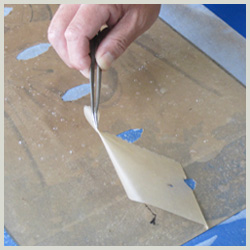
The first step in remounting kakejiku is to remove the old backing paper carefully.
(The act of removing the old backing paper is called “mekuru.”)

Generally, there are three layers of backing paper. They are applied in the order of “hada ura-uchi”(the first), “mashi urauchi”(the second), “sou urauchi”(the final) from the back of a “honshi” main artwork. When removing the paper, we start working on with outside, “sou urauchi”(the final) in reverse order.
The degree of difficulty varies depending on the condition of the work and the adhesive force of paste used in the former mounting.
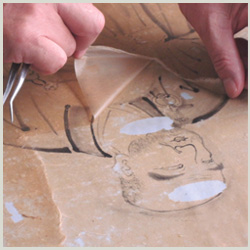
When it comes to degree of difficulty, the closer to a main work, the harder it will be. Therefore, removing “hada ura-uchi”(the first backing) is most difficult since it is directly applied to a main artwork. It is also regarded as the most difficult step in the whole repair procedure.
If this operation is not done properly by a skilled craftsman “hyougushi,” the work might be damaged.
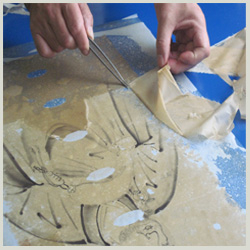
A “hyougushi” scroll mounter focuses all of his attention on his fingertips and strips the first backing paper carefully not to damage a main artwork.
An artwork reveals its true self as each backing paper is stripped away.
VIDEO: Remove Old Backing Paper
Omote-uchi: Protective Temporary Lining
Long-standing Challenge for Kakejiku Mounters: Removal of Old Backing Paper
Removing old backing paper would be the hardest part of restoring the damaged kakejiku. The backing paper is applied to the back of the artwork with paste. We can remove it smoothly if there is no significant damage to the artwork and the paste is not too strong.
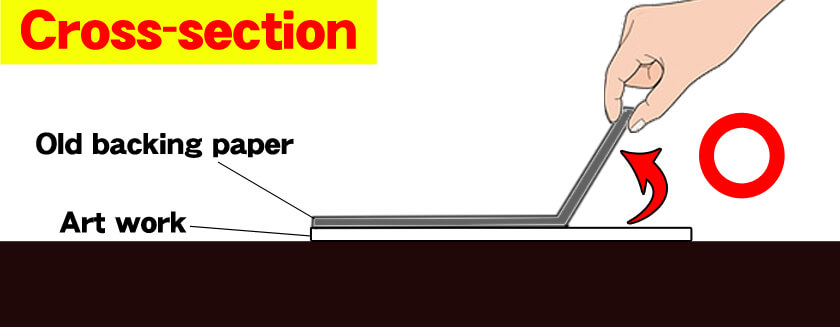
However, if there is significant damage to the artwork or the paste is too strong, the artwork will come along with old backing paper when removing it. What’s tricky about removing old backing paper is that we won’t know how tough it will be until we try.
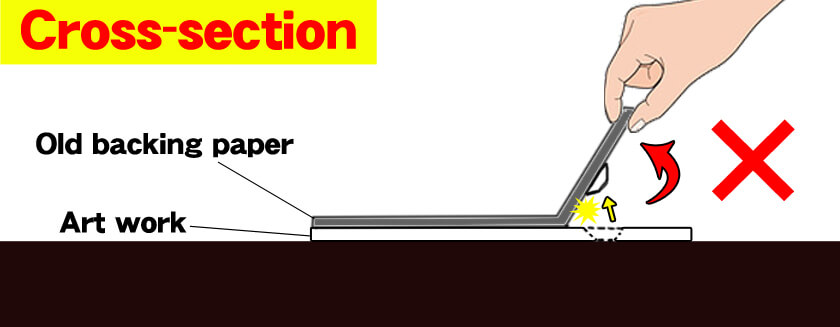


A Method Devised by Repair Specialists: Omote-uchi (Protective Temporary Lining)
As mentioned above, the process of removing old backing paper has been a headache for kakejiku mounters. To solve this issue, a special method was devised in the 1980s by leading repair specialists who engage in the conservation of the important cultural property. The method is called “Omote-uchi” (Protective temporary lining in English).
It is an application of facing paper made of special Japanese paper (e.g. rayon) to the surface of the artwork for protection. This will be done before removing the old backing paper. The facing paper supports the artwork with enough holding force while the old backing paper is removed from the artwork. It prevents the artwork from coming off together with old backing paper and thus, minimizes the losses and misalignment of the artwork.
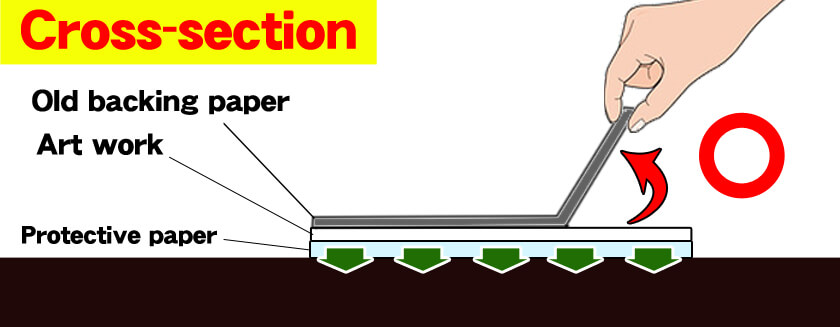
After successfully removing the old backing paper, we can move on to the next process of applying the new backing paper. The artwork won’t need protection any more at this point, so we remove the facing paper now. To remove the facing paper smoothly and not to damage the artwork, special paste is used as an adhesive for omote-uchi. The paste is of high-water solubility compared to the one for applying backing paper so that the facing paper will be removed easily when wet with a very small amount of water. This water will not affect the adhesive of the backing paper.
VIDEO: Omote-uchi Protective Temporary Lining
Cleaning
We removes dirt with our own, unique method. We must not spoil the antique beauty of the work that has caused its aesthetic value to grow over the years. It doesn’t always mean best to clean the work thoroughly. This is a very difficult decision.
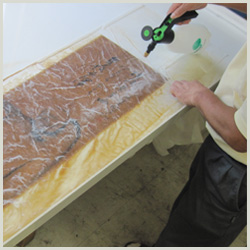
We remove dirt with cleaning solution.
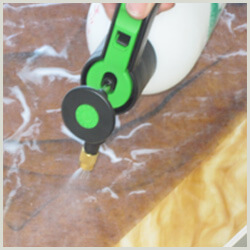
We clean off the dirt.
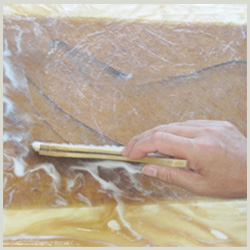
We remove the dirt gently with a brush.
Rinse Cleaning Solution
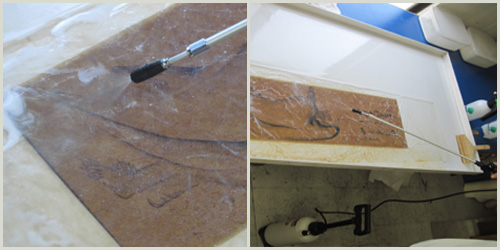
We remove the cleaning solution with a neutralizer.
Dirty Water
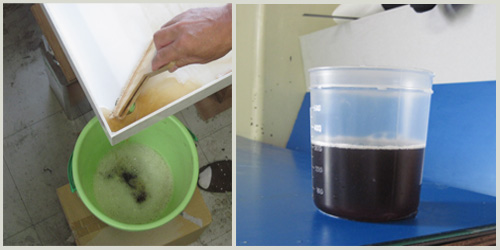
We can see the dirt removed from the work by cleaning. The water is colored by the dirt, not the cleaning solution. This shows how dirty the work was.
VIDEO: Cleaning
Removal Stains
Stains may occur in a work due to moisture, a chemical change and so on. We must use chemicals properly, depending on the condition of a work. A severely damaged work isn’t always able to stand up to chemicals, so the craftsman’s judgement is very important.
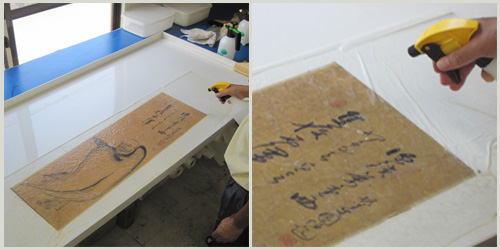
We must choose the appropriate method in consideration of various situations. The overuse of chemicals may damage a work, so we use them in small amounts.
Ore-fuse: Reinforcement
Creases result from repeated rolling and unrolling of a kakejiku (hanging scroll). They are the cause of friction in fabric or the main work as well as exfoliation of the pigments. We apply infill paper to creases or cracks on the backside of the main work after initial or subsidiary backing. Narrow strips of strong but thin pieces of Japanese paper are used. This crease reinforcement strip is called “ore-fuse” or “ore-ate.” Ore-fuse is applied from the back of the backing paper. We can reinforce creases and prevent them from occuring again. This operation is very delicate and time-consuming.

We apply ore-fuse (the long thin Japanese paper) to creases or cracks on the main work for the purpose of reinforcement.

If a work has severe damage, it is very hard to reinforce countless creases.
Video: Reinforcement
Hosai: Additional Toning
If the condition of a work is bad, a part of the artwork may be lost. Even with a backing, the work may still appear unnatural because of extensive deterioration. After obtaining the permission of a client, we sometimes add lines or color in order to fill in lost parts on the work.

This operation is very delicate because it requires an understanding about the work, a sensitivity to colors and a specialized knowledge about painting materials.
Video: Hosai Additional Toning
Contents Link
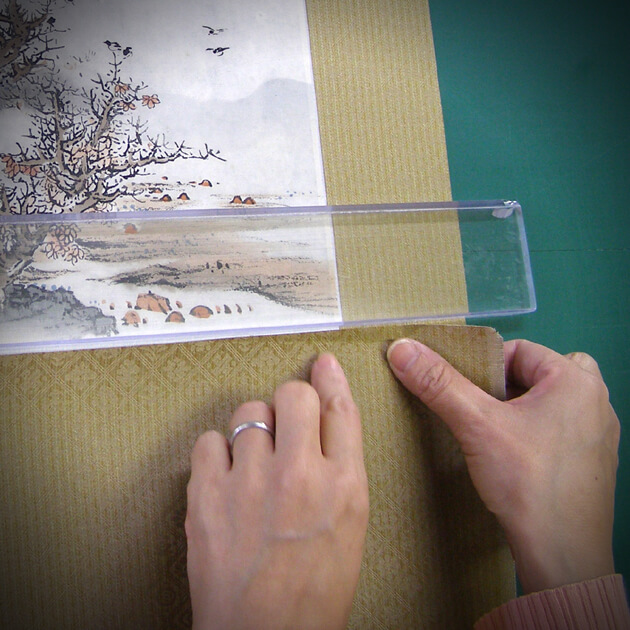 Inquiry Form for Mounting / Remounting Inquiry Form for Mounting / Remounting |

